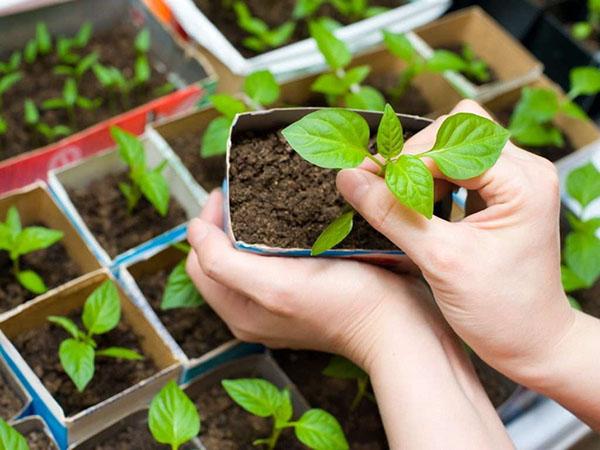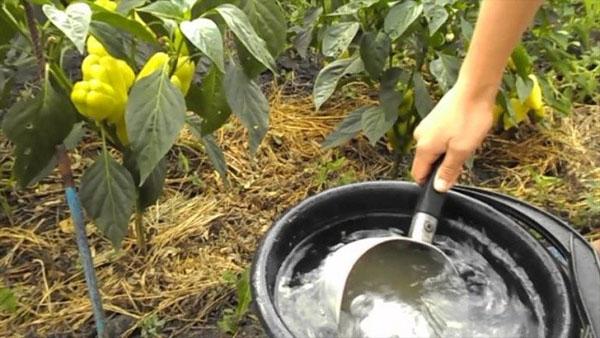Try yeast as a vegetable fertilizer
 Baker's yeast is widely used in cooking. Thanks to these microscopic fungi, we feast on rich buns, aromatic bread and granny's favorite pancakes. But restless gardeners have learned to use yeast as fertilizer for vegetables.
Baker's yeast is widely used in cooking. Thanks to these microscopic fungi, we feast on rich buns, aromatic bread and granny's favorite pancakes. But restless gardeners have learned to use yeast as fertilizer for vegetables.
How yeast can be good for plants

The seedlings are getting stronger, the color of the leaves is brighter, the ovaries are actively forming, why is this happening:
- During fermentation, substances are formed that stimulate root formation. According to the experience of gardeners, the roots appear 10-12 days earlier, and the size of the root system increases 5-10 times.
- Yeast enhances the multiplication of soil microorganisms. Microbiota breaks down organic matter to mineral components that are needed for the rapid growth of plants. The main minerals that affect the growth rate of the vegetative mass are phosphorus and nitrogen.
- Seedlings watered with such fertilizer grow faster and stretch less.
- Plants are getting stronger and healthier.
With frequent use of yeast, the soil is depleted in organic matter. Therefore, for 3-4 years, if you do not add humus, compost and manure in large quantities instead of a fertile area, you will get dry, lifeless soil.
On poor organic soils, the use of yeast is ineffective.
Crops suitable for yeast feeding
Novice gardeners are often interested in whether it is possible to feed peppers with yeast? And what about tomatoes, cucumbers, potatoes? Let's try to answer these questions.
Yeast can be used
 With a few exceptions, such dressings are beneficial for almost all garden plants, trees and shrubs. Bell peppers, tomatoes, cucumbers, greens, beans and root vegetables react especially well.
With a few exceptions, such dressings are beneficial for almost all garden plants, trees and shrubs. Bell peppers, tomatoes, cucumbers, greens, beans and root vegetables react especially well.
Fruit trees and shrubs grow very quickly with the use of fertilizers and leaf dressing on sourdough cultures, especially at a young age. Rooting of cuttings is much better, a powerful root rosette is formed.
Berry crops are very responsive to yeast feeding, especially strawberries and Strawberry... If you water the bush with yeast water during the transplant, then the rosette takes root much faster and gets sick less.
Yeast should not be used
This method gives poor results on plantings of bulbous and tuberous crops. Potatoes, sweet potatoes, onions, garlic are watery and tasteless. As you can see, yeast as a fertilizer for vegetables is not a guarantee of excellent results!
Yeast feed for seedlings
 It is difficult to overestimate the benefits of yeast for seedlings. The bushes look very stocky, bright and less prone to various diseases. After all, the substances that make up the yeast help a young plant to grow roots 5-10 times more than those of non-watered counterparts.
It is difficult to overestimate the benefits of yeast for seedlings. The bushes look very stocky, bright and less prone to various diseases. After all, the substances that make up the yeast help a young plant to grow roots 5-10 times more than those of non-watered counterparts.
Watering seedlings with yeast water with the addition of ash is recommended twice a season.
The first time this is done when the first true leaf appears, and the second during transplantation into open ground. Can be watered again before fruiting.
Feeding seedlings with yeast: the proportions and composition of yeast feeding are completely identical to those used for adult plants, any of the recipes described in the article will work equally well.
Methods for preparing yeast fertilizer
 Yeast has been used as a fertilizer for vegetables since time immemorial; there are a huge number of recipes for making yeast fertilizer. Both ordinary yeast and dry yeast are used. Sometimes gardeners prefer to make their own sourdough from wheat grains or hop cones. We will describe a few simple recipes that even novice gardeners can cook.
Yeast has been used as a fertilizer for vegetables since time immemorial; there are a huge number of recipes for making yeast fertilizer. Both ordinary yeast and dry yeast are used. Sometimes gardeners prefer to make their own sourdough from wheat grains or hop cones. We will describe a few simple recipes that even novice gardeners can cook.
The easiest recipe
 In 10 liters of warm water, 200 g of ordinary yeast or 100 g of dry yeast are diluted. The resulting solution is thoroughly mixed to dissolve all the lumps. Fertilizing from ordinary yeast is immediately used for watering, and from dry it is insisted for a day in a warm place.
In 10 liters of warm water, 200 g of ordinary yeast or 100 g of dry yeast are diluted. The resulting solution is thoroughly mixed to dissolve all the lumps. Fertilizing from ordinary yeast is immediately used for watering, and from dry it is insisted for a day in a warm place.
Yeast with sugar
 On 10 liters of water put 10 g of dry yeast and 2 tbsp. l. sugar, stir well and leave in a warm place until a frothy head forms on top and a characteristic fermentation smell appears. Then the mixture is diluted in a ratio of 1: 5. How to feed seedlings with yeast prepared according to this recipe? Just like any other vegetable crop, pouring a little at the root of each bush, while the earth must be moistened in advance.
On 10 liters of water put 10 g of dry yeast and 2 tbsp. l. sugar, stir well and leave in a warm place until a frothy head forms on top and a characteristic fermentation smell appears. Then the mixture is diluted in a ratio of 1: 5. How to feed seedlings with yeast prepared according to this recipe? Just like any other vegetable crop, pouring a little at the root of each bush, while the earth must be moistened in advance.
Top dressing with potassium and calcium
 In 10 liters of warm water dissolve 10 g of dry yeast, 5 tbsp. l. sugar, a glass of chicken manure extract and the same wood ash... The resulting mixture is thoroughly mixed and left for several hours in a warm place, then it is used for evening watering of garden crops.
In 10 liters of warm water dissolve 10 g of dry yeast, 5 tbsp. l. sugar, a glass of chicken manure extract and the same wood ash... The resulting mixture is thoroughly mixed and left for several hours in a warm place, then it is used for evening watering of garden crops.
Green cocktail for plants
 Water is poured into a 70 l container and a bucket of green grass, a pound of crackers or stale bread and 500 g of yeast are added. The resulting mass is thoroughly mixed and left to ferment in the sun for 1-2 days. When the leavened spirit appears, the infusion is used for watering and foliar feeding.
Water is poured into a 70 l container and a bucket of green grass, a pound of crackers or stale bread and 500 g of yeast are added. The resulting mass is thoroughly mixed and left to ferment in the sun for 1-2 days. When the leavened spirit appears, the infusion is used for watering and foliar feeding.
Hop sourdough
 You will have to tinker with this leaven, but the result is worth it. For cooking, take a glass of fresh or dried hop cones, pour 1.5 cups of boiling water and cook for an hour over low heat. The resulting broth is cooled, filtered through cheesecloth and 2 tbsp. l. sugar and the same amount of wheat flour, stir well and leave in a warm place for two days. 2 boiled potato tubers are rubbed into the fermented mass and left to ferment for another day.
You will have to tinker with this leaven, but the result is worth it. For cooking, take a glass of fresh or dried hop cones, pour 1.5 cups of boiling water and cook for an hour over low heat. The resulting broth is cooled, filtered through cheesecloth and 2 tbsp. l. sugar and the same amount of wheat flour, stir well and leave in a warm place for two days. 2 boiled potato tubers are rubbed into the fermented mass and left to ferment for another day.
The ready-made starter culture is used for watering plants 1 glass per 10 liters of water.
Wheat starter
 1 glass of wheat is soaked in water for several hours and germinated in wet gauze. Sprouted grain is ground in a meat grinder, 2 tbsp is added. l. sugar and the same amount of wheat flour. The mixture is diluted with water, until the consistency of a thick porridge, mix well and simmer over low heat for 20 minutes. The gruel is left in a warm place until it ferments (1-2 days), and then diluted in 10 liters of water and watered the plants.
1 glass of wheat is soaked in water for several hours and germinated in wet gauze. Sprouted grain is ground in a meat grinder, 2 tbsp is added. l. sugar and the same amount of wheat flour. The mixture is diluted with water, until the consistency of a thick porridge, mix well and simmer over low heat for 20 minutes. The gruel is left in a warm place until it ferments (1-2 days), and then diluted in 10 liters of water and watered the plants.
To prepare solutions, use heated water (36-38 ° C) because this is the ideal temperature for the development of the fungus. In cold water, the process will be too slow, and hot water will simply kill the fungus.
The fermentation container should be placed in a warm place, and watering should be carried out in the evening when the soil is well warmed up.
Is it worth using yeast as a fertilizer for vegetables

Despite the effectiveness of yeast feeding, there are still several disadvantages that any vegetable grower must know:
- Firstly, such feeding should not be applied more than twice a year. Frequent feeding provokes too active fermentation, which disrupts the structure and natural acid-base balance of the soil.
- Secondly, during fermentation, the soil loses calcium and potassium. Therefore, it is recommended to add bird droppings, wood ash or additionally mineral fertilizers to the top dressing.
Whether or not to use baker's yeast in his garden plot, each gardener decides on his own. However, everything is fine in moderation and yeast feeding must be approached carefully and carefully so that, instead of the expected benefit, it does not ruin the plants.